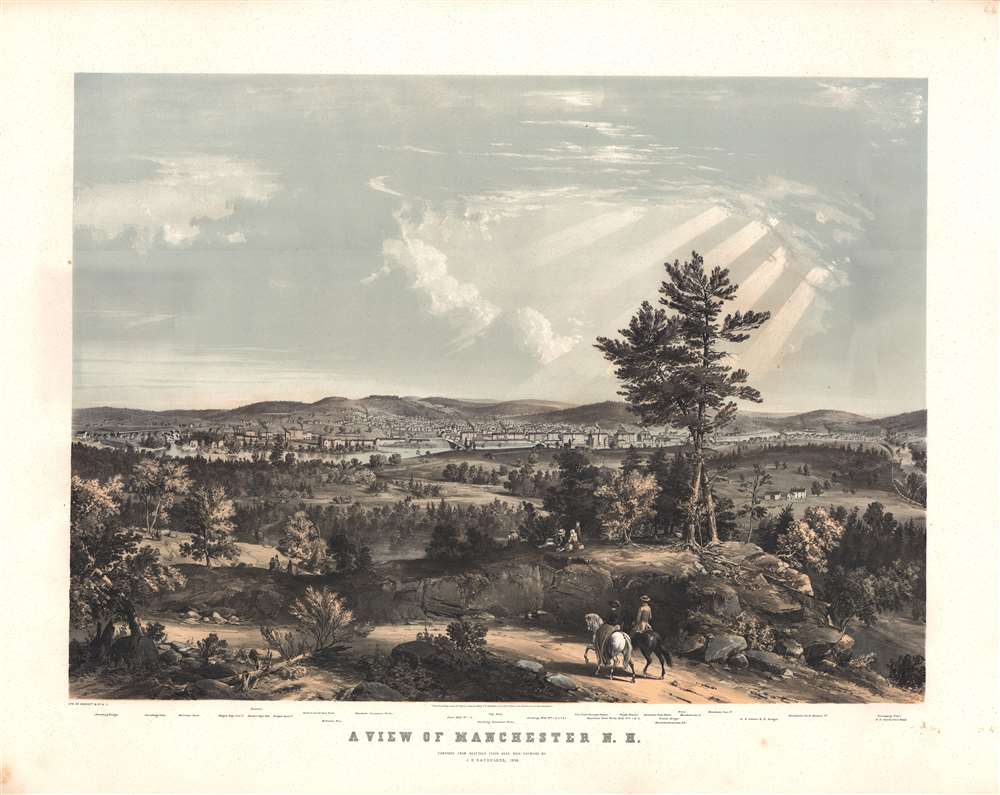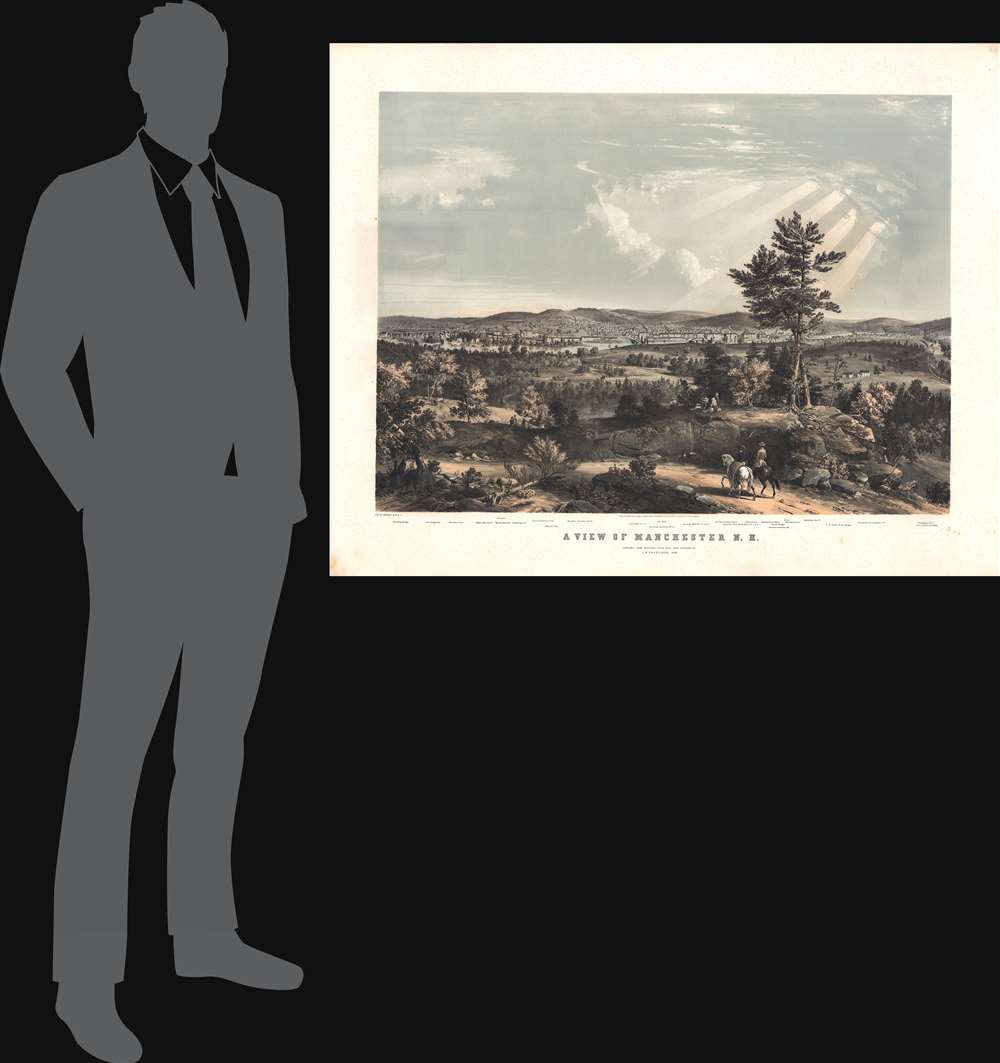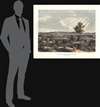1855 Bachelder Bird's Eye View of Manchester, New Hampshire
Manchester-bachelder-1855
Title
1855 (dated) 25.25 x 31 in (64.135 x 78.74 cm)
Description
The view was sketched from life by J. B. Bachelder, and committed to two-color lithograph by the New York lithographic firm of Endicott and Company. Endicott produced three other lithographs of Bachelder's sketches of Manchester, but they were all of a significantly smaller format and intended for inclusion in Endicott's 'Album of New England Scenery.' Bachelder lived in Manchester starting in 1854, so perhaps a certain civic pride in his new home led him to give the city more attention than his other subjects.
A Classically-Composed City View
The composition of the view is superb, surmounted by a luminous sky characteristic of much of Bachelder's work. The industrial nature of the city is presented harmoniously with beautiful rolling hills and forests. Farmhouses, groups of strollers, and carriages mark the middle distance, while in the foreground a well-dressed-and-horsed couple ride towards the city. Two young men and a woman recline in a shady spot on the hilltop. Just beyond the trio, another figure sits with his back to them, and to the viewer - with a blank page in hand, very likely meant to be the artist himself, sketching the view. It is not known if Bachelder was familiar with the work of the distant forbears in his field, but it is tempting to wonder. This sort of portrayal of a city, surrounded as this is with its fashionable denizens, is a theme that can be seen on city plans and views reaching back to the sixteenth century. The inclusion of the artist subtle self-portrait occasionally appears in the seventeenth century, most notably with Merian's 1646 depiction of Paris - whose bucolic setting this present work also recalls.Chromolithography
Chromolithography is a color lithographic technique developed in the mid-19th century. The process involved using multiple lithographic stones, one for each color, to yield a rich composite effect. Oftentimes, the process would start with a black basecoat upon which subsequent colors were layered. Some chromolithographs used 30 or more separate lithographic stones to achieve the desired effect. Chromolithograph color could also be effectively blended for even more dramatic effects. The process became extremely popular in the late 19th and early 20th centuries, when it emerged as the dominate method of color printing.Publication History and Census
Bachelder's drawing was composed and lithographed at Endicott and Company in 1855; there appears to have been a single edition of the view. It is rare: we are aware of only five examples catalogued in the Library of Congress, the Boston Athanaeum, the American Antiquarian Society Library, the New Hampshire Historical Society Collection, and the American Textile Historical Museum Library.CartographerS
John Badger Bachelder (September 29, 1825 – December 22, 1894), also spelled Batchelder, was an American portraitist, landscape artist, lithographer, cartographer, and photographer. In his life he was best known as the preeminent expert on the 1863 Battle of Gettysburg, of which he produced the most iconic representation. Bachelder was born in Gilmantown, New Hampshire and was educated at Captain Alden Partridge's Military School in Pembroke. Upon graduating he relocated to Reading, Pennsylvania, where he took a position at the Pennsylvania Military Institute. He became the head of that institution in 1851. In 1852 he was appointed colonel of the Pennsylvania State Militia. Around 1853 Bachelder returned to New Hampshire to pursue a career as an artist, publishing various views of New England towns; 1854 found him living and working in Manchester, and perhaps this is what led him to produce four views of the city - more than any other place he depicted in print. Bachelder's military training influenced his art materially and he developed a lifelong interest in depicting the dynamics of great battles on canvas. When the American Civil War broke out in 1861, Bachelder was working on a view of the Revolutionary War battle of Bunker Hill. From his work on the Bunker Hill view, Bachelder noted how difficult it was to reconstruct a battle long after the events when most major participants had passed on. He saw an opportunity in the outbreak of the Civil War and attached himself to the Union Army of the Potomac in the hopes of being present at a major battle. He was welcomed on the battlefield, where his accurate drawings helped the generals to better understand the conflicts in question. His most significant work his an impressive bird's-eye view of the Battle of Gettysburg. Though not present at the battle, he was there day's after, and claims to have interviewed the commanders of every regiment and battery in the Army of the Potomac, as well as thousands of wounded soldiers on both sides of the conflict. His work was so precise and significant he was commended to President Lincoln and later took a position as Superintendent of Tablets and Legends for the Gettysburg Battlefield Memorial Association. He is responsible for the monuments and battlefield markers, both Union and Confederate, that can still be noted today at Gettysburg. He also organized reunions and battlefield tours. Bachelder died of Pneumonia in Hyde Park, Massachusetts, in 1894. He is interred in his family plot in Nottingham, New Hampshire. More by this mapmaker...
Endicott and Company (fl. c. 1828 - 1891) was a New York based family run lithography firm that flourished throughout the 19th century. The firm was founded by George and William Endicott, brothers who were born in Canton, Massachusetts. George Endicott (June 14, 1802 - 1848) trained as a lithographer under Pendleton Lithography from January 1826. He later worked as superintendent of Senefelder Company until the summer of 1828. Afterwards, in 1830, he relocated to Baltimore and partnered with Moses Swett. Endicott and Swett relocated to New York City in December 1831. They remained partners until July 1834 when the relationship dissolved. George set up shop on his own account at 359 Broadway. William Endicott (1815 - 1851), George's younger brother of 14 years, joined the firm in 1840 and was made a partner in 1845, after which the name of the firm was changed to G. and W. Endicott. George Endicott died shortly afterward, in 1848, but William continued operating the firm as William Endicott and Co. until his own 1851 death at just 35 years old. The firm was carried on by his widow Sara Munroe Endicott until it was taken over by her son, Francis Endicott, who ran the firm from 1852 to 1886. George Endicott, Jr. subsequently ran the firm from 1887 to 1891. Peters, in his important work on American lithography America on Stone writes 'it is hard to summarize the Endicotts. They did everything and did it well . . . [they] worked with and for Currier and Ives, yet in spite of all that much of their work lacks real individuality.' The Endicott firm was responsible for many 19th century views and plans of New York City and state as well as plans of Sacramento, California, and the Midwest. Learn More...




